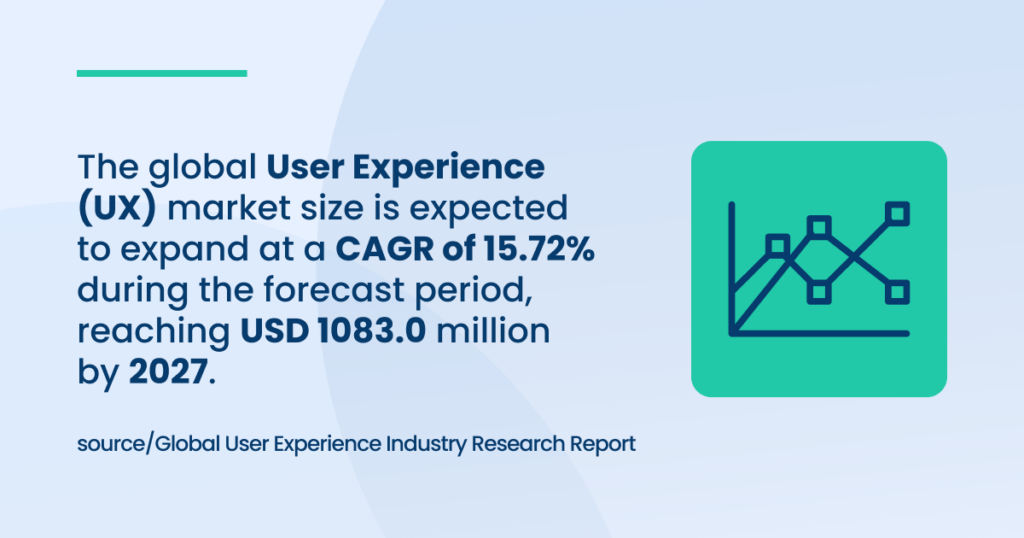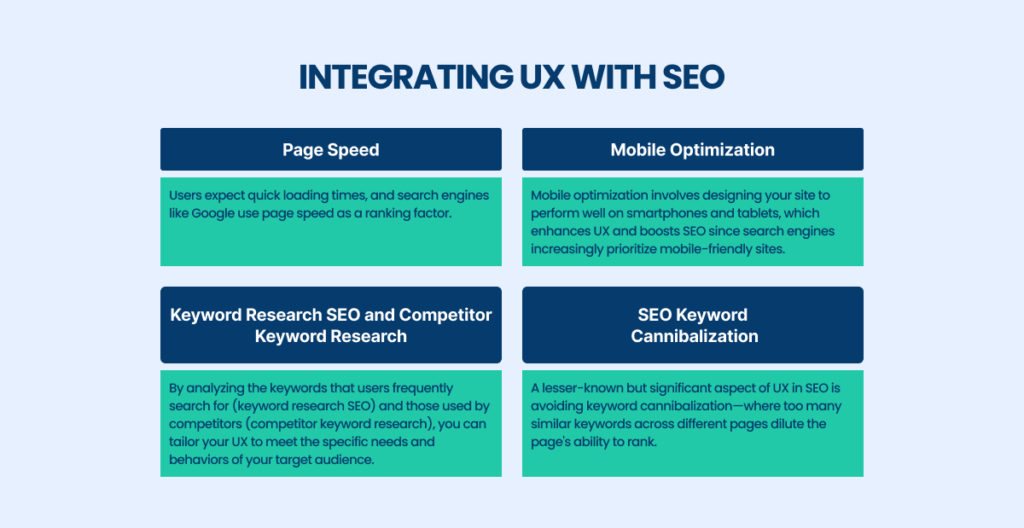Imagine you’re lost in a big library.
SEO is like having a map leading you to the right shelf with the book you need.
But UX makes that shelf well-organized, with clear labels and maybe even a comfy armchair for browsing. Both are crucial for a successful information quest!
These two aren’t rivals but teammates! Great SEO attracts users, but a fantastic UX keeps them engaged and happy.
Moreover, if a good SEO Agency understands the essence of the collaboration, they will create a website that’s not just a destination but a delightful journey for your users.
According to the Global User Experience (UX) Market Research Report for 2024, the global user experience (UX) market size was estimated at USD 548.91 million in 2023.

The blog post will explain how superior UX enhances on-site SEO, covering essential principles from mobile optimization to advanced AI strategies, demonstrating common UX mistakes to avoid, and providing practical tips.
Defining User Experience (UX)
User Experience (UX) is pivotal in shaping how effectively a website can serve its purpose by influencing visitor satisfaction and SEO rankings.
Effective UX SEO strategies focus on creating a seamless interface that enhances user satisfaction and search engine rankings.
Source: Cognitive market research
A well-designed UX can significantly boost a site’s visibility and performance in search engine results.
Simple Explanation of UX
User Experience (UX) refers to users’ emotions and attitudes when interacting with a website, application, or software. This includes everything from how easy the platform is to navigate to how quickly users can complete their desired actions without frustration.
Effective UX design ensures that users find value in what you provide, which is crucial for retaining visitors and converting them into customers.
Components of UX
- Usability: This is perhaps the most critical aspect of UX, ensuring users can navigate and interact with your site efficiently. High usability helps reduce user frustration, encourages longer visits, and increases the likelihood of returning users.
It’s a fundamental component of SEO strategy as search engines prioritize sites that provide a good user experience, particularly through search engine algorithms.
- Accessibility: Accessibility ensures that people of all abilities and disabilities can use your website. This includes designing for users on mobile devices, considering color contrasts for visibility, providing text alternatives for images, and ensuring navigation is possible using a keyboard only.
Accessibility is a moral obligation and a legal requirement in many jurisdictions. From an UX SEO perspective, accessibility broadens your audience reach and interaction, positively impacting your search rankings.
- Interaction Design: Interaction design refers to creating engaging interfaces with logical behavior. User’s interactions with your interface should feel intuitive and rewarding.
Key interaction design principles include consistency, predictability, and feedback. When users complete an action, immediate feedback (like a confirmation message) reassures them that the action has been successful.
Integrating UX with SEO
Integrating UX SEO means aligning your site’s design and content with the needs of both users and search engines.

Essential UX Principles for SEO
Creating a seamless user experience (UX) enhances a website’s search engine optimization (SEO).
Not only does it improve user interaction with your site, but it also influences how search engines assess and rank your content.
Here, we explore several foundational UX SEO principles that significantly impact the outcomes.
Responsive Design and Mobile Optimization
Mobile devices dominate internet access in today’s digital landscape, making mobile optimization a cornerstone of effective UX and SEO strategy.
Source: Forecast of Mobile Users Worldwide, Statista
The concept of mobile-first design is pivotal due to mobile indexing, where search engines like Google prioritize the mobile version of a site for indexing and ranking.
This approach isn’t just about making a site accessible on a smartphone; it’s about designing from the ground up for mobile functionality, ensuring that all elements perform seamlessly across different screen sizes and devices.
A mobile-first UX focuses on streamlining content and navigation to enhance readability and interaction on smaller screens.
Source: Color whistle
This practice improves user engagement and boosts SEO by reducing bounce rates and increasing time on site—key user engagement metrics that search engines consider when ranking sites.
Incorporating mobile-first design into your SEO strategy requires rigorous keyword research SEO and competitor keyword research to understand how users search on mobile devices versus desktops. Often, mobile users employ shorter, more concise keywords, and adapting your content to these preferences can enhance your visibility in mobile search results.
Optimizing Site Speed
Page speed is a critical factor for both user satisfaction and SEO. Search engines recognize that users prefer fast-loading sites, making page speed a significant ranking factor. A delay of just a few seconds can increase bounce rates and reduce the overall positive user experience, negatively impacting your SEO performance.
Source: Color whistle
Evaluate your performance with tools like Google’s PageSpeed Insights to enhance site speed. This tool not only measures the speed of your site but also provides actionable recommendations for improvement. Key techniques to improve site speed include:
- Optimizing Images: Ensure that images are not larger than necessary, are in the right file format, and are compressed for the web.
- Enabling Compression: Use software applications for file compression, like Gzip, to reduce the size of your CSS, HTML, and JavaScript files.
- Minifying CSS, JavaScript, and HTML: You can increase page speed by removing unnecessary spaces, commas, and other characters.
- Reducing Redirects: Each time a page redirects to another page, your visitor faces additional time waiting for the HTTP request-response cycle to complete.
- Improving Server Response Time: Address performance bottlenecks such as slow database queries, routing, or inadequate memory.
- Using a Content Delivery Network (CDN): CDNs distribute the load of delivering content by storing copies of your site in multiple geographically diverse data centers.
By implementing these strategies, you can significantly enhance your site’s load time, leading to better SEO rankings due to improved user engagement metrics.
Streamlined Navigation
To boost your website’s visibility, integrating UX SEO practices like optimizing navigation and improving page speed is crucial. Streamlined, intuitive navigation is essential for a positive user experience and effective SEO. Navigation influences how quickly users find what they need on your site and how easily search engines can index your pages.
Good navigation should feel intuitive, helping new and returning visitors find information without frustration, which reduces bounce rates and increases the likelihood of conversions. Many businesses underestimate the importance of UX SEO, not realizing how much user experience impacts organic search performance.
Best practices for creating a logical, easy-to-navigate website structure include:
- Consistent Navigation: Keep your primary navigation consistent across all pages. Changing the layout or positioning can confuse users and lead to poor user experience.
- Descriptive Labels: Use clear and concise labels for navigation links to help users and search engines understand your content. Avoid generic labels like ‘Products’ or ‘Services’ and opt for specific descriptions that relate to the content (e.g., ‘Women’s Running Shoes’).
- Hierarchical Structure: Organize information hierarchically, starting with broad categories and narrowing down to specific items. This helps users navigate your site and prevents SEO keyword cannibalization by clearly distinguishing between content topics.
Enhancing Content for UX and SEO
Content is critical to User Experience (UX) and Search Engine Optimization (SEO). Enhancing content involves crafting valuable information and presenting it in ways that optimize engagement and visibility.
Here’s how to effectively align content layout, visuals, readability, and accessibility with UX SEO principles to boost overall site performance.
Layout and Structure
An intuitive layout and structured content are foundational to providing a positive user experience and directly affect SEO. When content is easy to scan and logically organized, users interact more effectively, leading to better retention rates and reduced bounce rates—key metrics that influence SEO.
Tips for creating scannable, engaging content layouts include:
- Use of Headers and Subheaders: Organize content using a hierarchy of headers (H1, H2, H3, etc.) to guide users through your content and to help search engines understand the main topics of your web page. This hierarchical structure aids in SERP features, helping your page to stand out in search results.
- Bullet Points and Numbered Lists: These help break down information into digestible pieces, making it easier for users to quickly scan and comprehend the content.
- Short Paragraphs: Keep paragraphs short (2-3 sentences) to avoid overwhelming your readers. This structure is particularly crucial for mobile SEO, as smaller screens can make large blocks of text appear daunting.
- Strategic Use of White Space: Adequate spacing between elements improves readability and reduces visual clutter, allowing users to focus on your content without distraction.
- Interactive Elements: Use interactive elements like accordion menus, tabs, or clickable sliders to engage users and provide information in a layered approach. This can enhance user engagement and dwell time, the indicators that UX SEO positively affects.
White hat SEO practices are crucial for achieving long-term success in search engine rankings. Therefore, understanding the distinction between on-page SEO vs. off-page SEO is essential.
By implementing these layout strategies, you cater to user preferences and align your content structure with SEO best practices that enhance findability and readability.
Optimizing Visuals
Visual content, including images and videos, enhances the user experience and boosts SEO. Proper optimization of visuals can lead to faster loading times, better engagement, and increased likelihood of sharing, all of which contribute to higher SEO rankings.
SEO image optimization also falls under on-page SEO, where images are tagged with descriptive, keyword-rich alt texts to improve their visibility in search results, considering the importance of title tags and meta descriptions.
Source: User guiding
Importance of image and video optimization for UX and SEO:
- Compression and Quality: Compress images and videos to reduce file sizes without compromising quality. This balance is crucial for maintaining fast page speeds and high-quality visuals, contributing directly to better UX and SEO.
- Descriptive Alt Texts: Alt texts help search engines understand the content of an image or video, which is vital for web page indexing. They also enhance accessibility for users who rely on screen readers, linking to how UX SEO affects them.
- Responsive Design: Ensure images and videos are responsive and adapt to different screen sizes and resolutions. This is particularly important for mobile SEO, as it ensures all users have a consistent experience regardless of device.
- Appropriate Use of Visuals: Use visuals that add value to your content and align with search intent optimization. They should clarify or complement the text, not just serve as decoration.
- SEO for Visual Content: Include targeted keywords in file names and use structured data to help your images and videos appear in relevant searches. This can improve visibility in image search results and contribute to overall SEO efforts.
Optimizing visuals enhances appearance and improves users’ interactions with your content and its effectiveness in being indexed and displayed in search results.
Content Readability and Accessibility
Readability and accessibility are crucial elements of UX that significantly impact SEO. Ensuring content is easy to read and accessible to all users, including those with disabilities, can greatly enhance site usability and search engine rankings.
Writing styles and accessibility features that enhance UX SEO:
- Clear and Concise Language: Use simple language and avoid jargon to make your content accessible to a broader audience. This approach supports UX by making information more digestible and enhances SEO by aligning with search intent optimization.
- Logical Flow: Ensure your content flows logically from one section to another, aiding comprehension and keeping users engaged longer on your page.
- Accessibility Features: Incorporate text-to-speech, keyboard navigation, and content accessible through assistive technologies. These adaptations fulfill legal requirements and expand your audience reach, reflecting how UX affects SEO.
- Inclusive Design: Design your content to be inclusive, considering color contrasts for those with visual impairments and providing captions or transcripts for audio and video content.
Partner with [A] Growth Agency to Enhance Your User Experience For On-Site SEO
Great SEO attracts users, but a fantastic UX keeps them engaged and happy. Search engines themselves even consider UX a factor in ranking websites. So, by optimizing for both, you create a website that’s not just easy to find but a pleasure to use – a win-win for everyone!
[A] Growth Agency can be your advisor in the process, guiding you through the nuances of both on-page and UX strategies.
Excellence is our standard. At heart, we’re a team of data-driven growth marketers focused on delivering scalable results. We believe in the power of analytics and insights to fine-tune every aspect of your digital presence.
From meticulous on-page SEO enhancements—optimizing your title tags and meta descriptions- to rigorous off-page SEO efforts, we ensure that your website attracts and retains high-quality traffic.
If this can benefit your business, don’t think long!

